Odds & Ends: Kaldheim, Part 2
Last week, I started answering your questions about Kaldheim. This week, I continue.
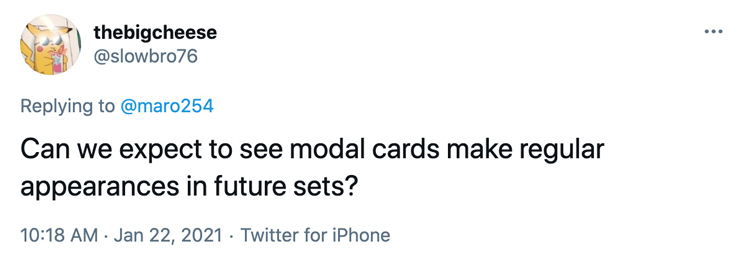
Modal double-faced cards (MDFCs) require additional production issues (for example, they have to be printed on their own sheet) as well as create some logistical play issues (you need opaque sleeves or a helper card to play them), so they aren't something we can just throw in any set. That said, a large majority of the audience seems to really like them and there's a lot of (practical) design space left, so I'm optimistic they'll return, although I'm not sure it will be "regularly." Would you settle for "occasionally"?
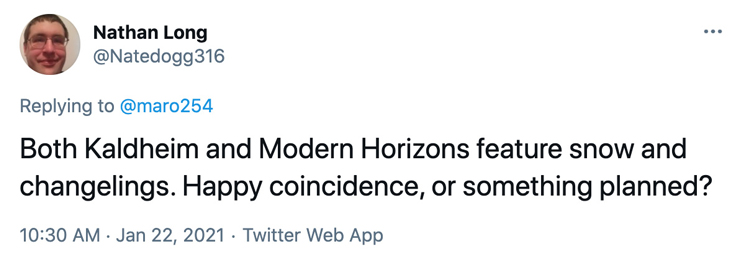
There's no mechanical correlation between them, so it's more happenstance than something planned. I do think the popularity of both items in Modern Horizons made it easier to bring them both back in Kaldheim.
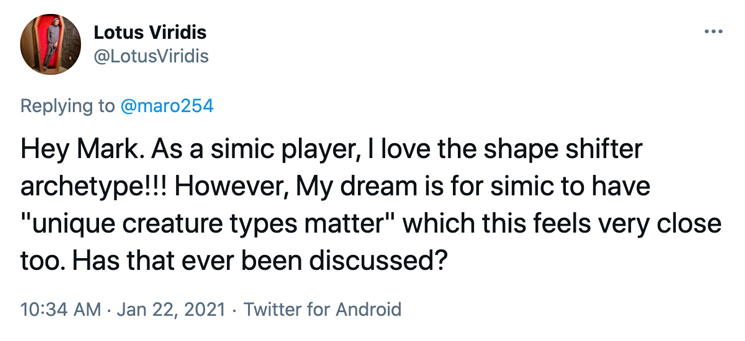
We've definitely talked about a creature type theme that encourages you to play all different creature types rather than traditional tribal themes, which require you to play a lot of one or a few creature types. The biggest issue is, ironically, Shapeshifters. Well, technically the changeling mechanic. It complicates things. For example, we can't make scaling cards that count creature types because a single changeling would ramp it up to
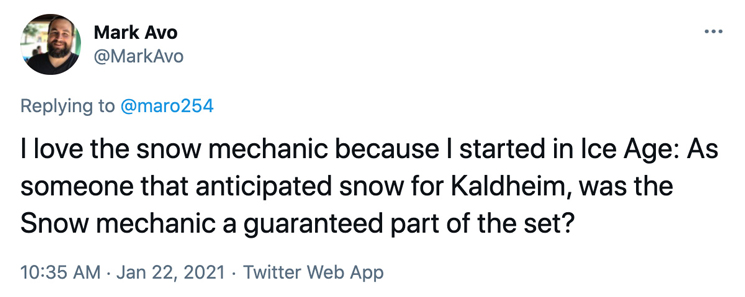
It was not. In fact, it wasn't at all part of the vision design. It did come up. Obviously, one thinks of cold climates when thinking of Norse mythology, but, you see, snow's first three outings (Ice Age, Alliances, and Coldsnap) didn't really go all that well. Admittedly, part of that was the execution of the mechanic, but R&D has always been kind of cold to snow (pun, as always, intended). So, when it came up in vision design, we decided not to pursue it.
Meanwhile, Modern Horizons originally had a dual land cycle it was trying that didn't work out, and we were looking for a different land-focused thing we could do. It turns out we were getting a lot of requests for snow-covered basic lands, as they were being played in some formats and we hadn't printed them since Coldsnap, so it was suggested we include full-art snow-covered basic lands in the set, something that we'd never made before. It seemed odd to have snow-covered basic lands if the set didn't have any snow-related cards, so the Set Design team added the theme to the set. It kind of snowballed (just always I assume I meant to make the pun) and ended up playing a larger role than we expected.
When David Humpherys started set design on Kaldheim, he asked the same question we had at the beginning of vision design. Did the set want snow? But instead of three sets where it performed poorly as his model to look at, the latest set to use it was Modern Horizons, and although it hadn't been released yet, R&D was enjoying how snow was playing out in the set. Because we anticipated it would be popular, Dave was both more comfortable using snow and believed that there would be some expectation of it, so he added it to Kaldheim.

Most of the time, before a set begins, we have a decent sketch of what happens storywise big picture in the set. How does it fit into whatever larger storyline is going on? Usually, we only know the major characters of the story, which means the protagonists and antagonists, who are often planeswalkers. The Vision Design team figures out the major themes, the set structure, and usually the majority of the mechanics. We design cards, but they exist more as a proof of concept than necessarily the actual cards that will be printed in the final set. The rest of the characters are usually figured out and designed during set design. The details of the story are usually finalized once we get the writer, but that usually happens late during set design.
That means the answer is (most often): big picture lore, main characters, mechanic design, some card design, legendary character selection, more card design, detail lore.
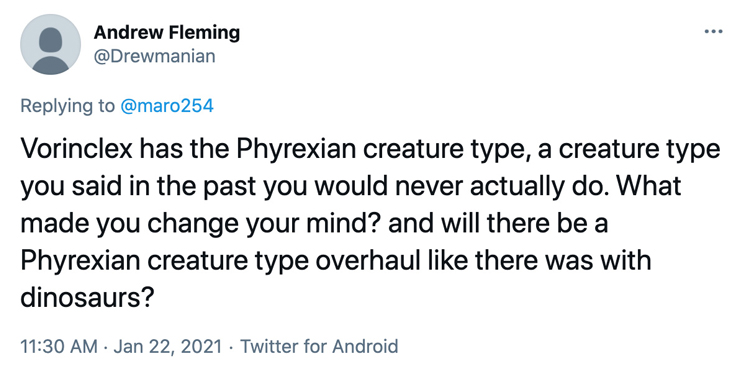
The decision to make Phyrexian a creature type follows an age-old R&D process.
1) Figure out that we didn't do something we wish we had.
The Phyrexians first showed up in Antiquities and didn't get a creature type. I think this was mostly because there just weren't a lot of Phyrexians in Antiquities (Phyrexian Gremlins, Priest of Yawgmoth, and Yawgmoth Demon). The Phyrexians then showed up from time to time, but not all those sets had style guides, so it wasn't always clear what was and wasn't a Phyrexian. I think it was around the time we were doing The Weatherlight Saga that I first pitched the idea of the Phyrexians having a creature type. They were going to be a big villain in the story, and I found it frustrating that there wasn't any way to mechanically care about them.
2) Decide we missed our opportunity to do it.
Other members of R&D were sympathetic with my desire to make it something we could mechanically care about, but they were skeptical that it was something we needed. The general consensus was that it would have been nice if Antiquities had made a Phyrexian creature type, but it didn't, so the moment had passed.
3) Someone makes a push to reverse the decision.
When I was leading Scars of Mirrodin, the reintroduction of the Phyrexians as a major Magic villain, I again pitched my desire to have a Phyrexian creature type. The storyline was making a new breed of Phyrexian. I argued that could be our rationale for doing it.
4) It gets shot down again.
We basically had the same argument again, although this time with different people. Everyone agreed it would be nice had we done it, but as he hadn't, it was too late, so we didn't do it.
5) "Think of the future"
Vorinclex in Kaldheim was our next reintroduction of the Phyrexians. Again, the topic came up. (Not by me this time—this happened in set design long after I had moved onto a different set.) This time the argument was "we keep not doing this and then are unhappy years later that we didn't do it. Let's not do that this time." When someone asked me my opinion on the topic, I said, "Of course, we should do it. I've been trying to do it for years."
6) Fix the past.
So, yes, we are planning to errata old cards. Everything that's a Phyrexian will be gaining the Phyrexian creature type (although there's some fuzziness on some creatures). I don't think anything will be losing a creature type, though. The change should just be additive.
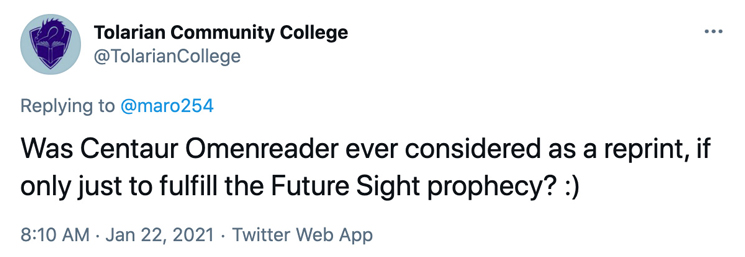
I believe it was talked about, but it was decided that Centaurs are a little too Greek mythology to feel at home in a Norse-inspired set. That's one of the difficulties of trying to use futureshifted cards. They have to match both the mechanical and flavor identity of the set. Quite often, it perfectly fits one, but it's a mismatch with the other.
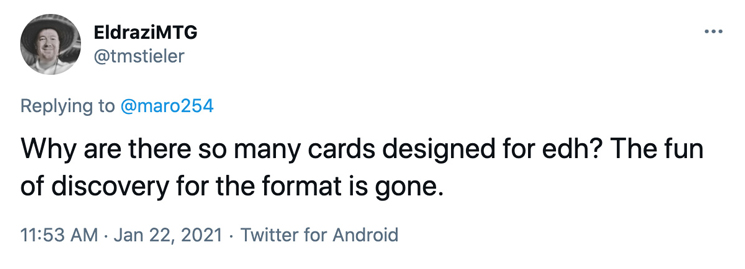
There are ramifications to being the most played format. R&D is going to design cards for it. However, that doesn't mean there isn't room for a lot of discovery. The key is to give yourself constraints for your deck that force you to look places you might normally not. For example, try playing a legendary creature that you've never seen played as a commander before. Pick a piece of pop culture you adore and use that as inspiration for a theme. Limit yourself to only ten sets to pull from. A lot of fun can come from giving yourself constraints.
I do hear the larger note that we could be less prescriptive with the cards we design with Commander in mind. That is a note we've heard from numerous players and are taking to heart. The goal is to make more cards that let you explore cool things in Commander and less that force you to have to play a card if you're playing a certain theme.

I'd say we're experimenting with it. Dave Humpherys was the lead set designer for both Ikoria: Lair of Behemoths and Kaldheim, so I think he was trying to tackle a design problem that he realized was solved by using a keyword counter. I think the future of keyword counters, as a deciduous thing, has a lot to do with how we witness the audience using them in Kaldheim. I'm honestly not sure how it's going to turn out.
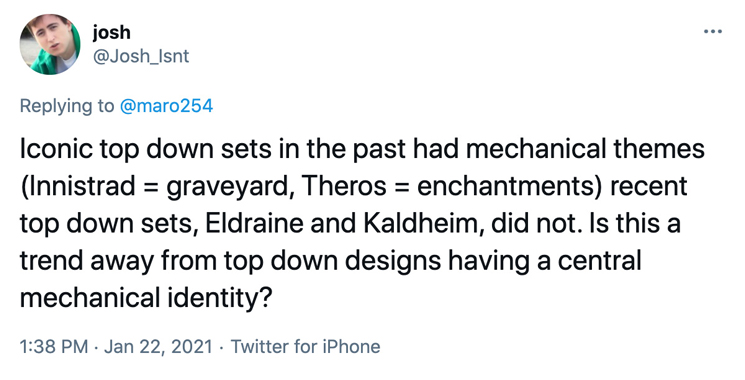
I think you're oversimplifying things. Top-down designs are defined by the fact that they use the flavor as the glue to make various mechanics feel connected. Innistrad used graveyard because that played into its horror feel, but it also used transformation, tribal, and "death matters." Kaldheim is doing something similar. It has a combat-matters portion, a tribal portion, a spell tempo portion, and an MDFC portion. All those come together to give the set an overall feel. If you wanted to pick one theme to focus on, like you're doing with the other sets, I'd probably pick "combat matters," as that takes up the biggest footprint in the set. In short, nothing is changing with how we're designing top-down sets.
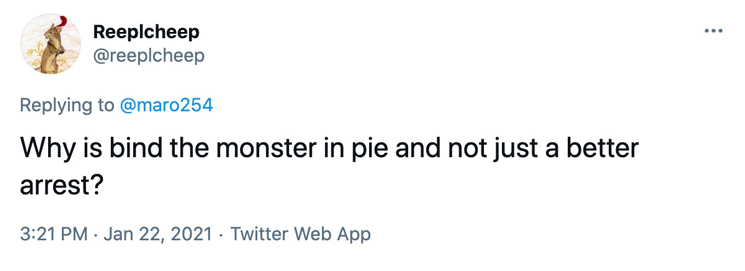
Let me first answer the question you're technically asking, and then I'll answer the question I believe you're intending to ask.
Is Bind the Monster in color pie? Yes. It's what R&D calls a dehydration effect—an Aura that keeps a creature from untapping, which often taps it when enchanting it. The bend of the card is that it deals damage to you, but paying life or taking damage as a (pseudo)cost is something blue (any color, really) can occasionally do, so it's not even a big bend.
Should blue be allowed to have this effect at this cost? That's a power-level question, so we're now moving to something outside my area of expertise. Is there a distinct difference between "can a color do something" and "how powerful should that effect be"? (And yes, I understand that power level does inform the color pie from a practical play standpoint.) Two different groups address these two issues. The Color of Council decides if a color should be able to do something, and Play Design decides how strong any one particular card should be. The Council of Colors does delineate who is supposed to be best at an ability, what we call primary, secondary, and tertiary (you can read my Mechanical Color Pie article to see a lot of this defined), but that explains what's supposed to happen the majority of the time. At any one moment in time, it's possible for a secondary color to do something better than a primary color. Gauging power level is not an exact science. We're designing environments with enough complexity that millions of players can't crack it instantly, which means that even we don't know exactly what's going to happen.
Here's where this gets problematic. For most of Magic's life, the most played format was Standard, a rotating format. That meant that while there were ebbs and flows, the color pie kept swinging back to center. Yes, maybe there's a moment where the secondary color got the best card, but that happened infrequently and when it rotated out, things went back to normal. We now live in a world where the most played format doesn't rotate. Once something enters the format, it's there forever. This plays a bit of havoc with the chaos of designing Magic cards and Magic sets. We want to experiment and try different things. One of the great joys of a trading card game is that we continue creating new content, and that keeps the game fresh, but we no longer have the safety valve of rotation.
This is my long-winded way of saying we're going to occasionally make cards (and I'm honestly not sure if Bind the Monster is one of them) that push boundaries that with hindsight we might not have pushed. Designing Magic can get messy in parts, but I do believe that it's a byproduct of what makes the game so special.
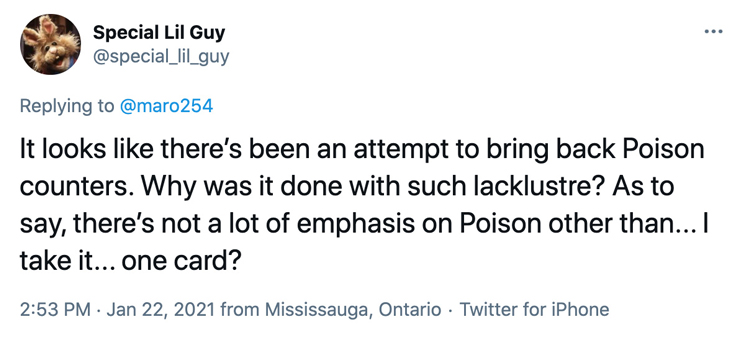
During set design, they realized they had an opportunity to make a flavorful card. It was a legendary creature that granted the ability to creatures, meaning that as a Commander, it could let you build a poison deck with just one card that mentioned poison. That seemed pretty cool. This wasn't a case of a set that started with a giant poison theme and got whittled down to one card. Only one card ever had poison.
This doesn't mean we won't do a set one day with a poison theme; it just means in this case, for this set, it was the best way to use poison. Remember, not every mechanic has to be blown out as a major theme to add value. Mistform Ultimus, for example, was a fun card that had every creature type without changeling having to be in the set.

I think foretell is a very solid mechanic, and yes, I do think we'll see it again. Does it have the potential to become a keystone mechanic (things I grade as 3 on the Storm Scale—mechanics we use all the time that aren't deciduous—cycling, flashback, kicker, etc.)? It's far too early to tell. My gut says it's closer to a 4 or 5 than a 3 on the Storm Scale, but it wouldn't surprise me if it ends up being better than I think.
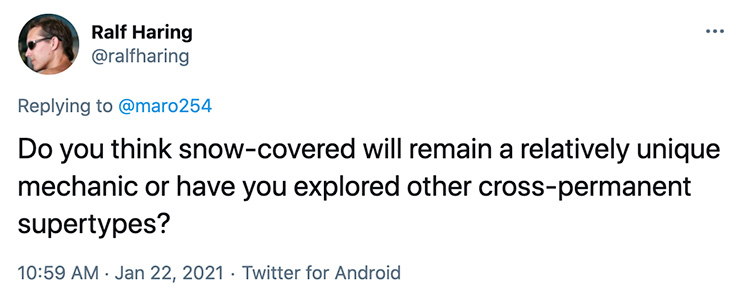
Let me start by clarifying something. Subtypes, things like Goblin or Rune or Shrine, belong to a single card type (with the exception that instants and sorceries can share a subtype). Supertypes, things like legendary or snow, can go on any card type. So, all supertypes are "cross-permanent" (or, more technically, cross-card type).
So, are we going to make more supertypes? I believe we will. Devoid (from Battle for Zendikar) taught me that players have issues with mechanics acting as markers (meaning they don't do anything other than allow other cards to refer to them). I believe supertypes better fill this role. You can use flavorful words to explain why the supertype is on the card, and I don't believe there's the same expectation that the supertype has to carry mechanical weight. My gut says, for this purpose, we will be making more supertypes. I should stress that doesn't mean we might not make new ones that do carry mechanical baggage, I just expect that to be the minority. Anyway, just my thoughts on the topic.
I'm a Little Norse
That's all the time we have for today. I want to thank everyone who took the time to send in a question. My apologies that I couldn't get to them all. As always, I would love to hear any feedback on today's column, any of my answers, or Kaldheim in general. You can email me or contact me through any of my social media accounts (Twitter, Tumblr, Instagram, and TikTok).
Join me next week for "One Thousand and Counting."
Until then, may you find the answers you seek.
#807: Angels, Part 2
#807: Angels, Part 2
34:04
In this podcast, I continue to share design stories about various Angel cards.
#808: Evan Erwin
#808: Evan Erwin
30:28
I interview Evan Erwin, a longtime creator of Magic content.
- Episode 806 Angels, Part 1
- Episode 805 Olivia Gobert-Hicks
- Episode 804 Luis Scott-Vargas

